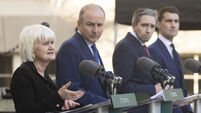“Do unto others as you would have them do unto you”: War of words led to a universal human rights declaration

Today marks the 70th anniversary of the Universal Declaration of Human Rights, which has played a pivotal role in the quest for global justice, writes .

IN his closing speech in the 1961 film Judgment at Nuremberg, Judge Dan Haywood (Spencer Tracy) declares: “Before the people of the world, let it now be noted that here, in our decision, this is what we stand for: Justice, truth, and the value of a single human being”.
Earlier, the judge said those charged had participated in “the commission of crimes so vast and heinous that they beggar the imagination”.
The film, scripted by Abby Mann and directed by Stanley Kramer, was a fictionalised account of one of the secondary trials that followed the main Nuremberg tribunal sitting in judgment of the top Nazis leaders, political and military, which lasted from November 20, 1945, to October 1, 1946.
These trials and the international military tribunal in Tokyo, which delivered its verdict on November 4, 1948, on 28 Japanese military and government officials accused of committing war crimes and crimes against humanity, caused some controversy, especially among legal scholars.
They were seen as “victors’ justice”, and the “moral superiority” of the Americans, in particular, especially after the dropping of the atom bombs on Hiroshima and Nagasaki on August 6 and 9, 1945, and the British after the carpet bombing of Dresden (a city with no military significance) on February 13, 1945, was questioned.
Other criticisms related to the terms of the charter establishing the trials agreed by the Allies in London on August 8, 1945. This was drawn up against the background of a dispute among the Allies over whether there should be any Nuremberg trial at all.
Winston Churchill wanted summary executions. That there was a trial at all was due to the insistence of US president Harry Truman (who had replaced Franklin D Roosevelt, the latter having died of a stroke on April 12, 1945).
Harlan Stone, chief justice of the US Supreme Court at the time, described the proceedings at Nuremberg as “a sanctimonious fraud” and a “high-grade lynching party”.
Notwithstanding these criticisms, most observers considered the trials (held in the Bavarian city that had been the site of annual Nazi propaganda rallies) as a milestone in the development of international law.
“For all these failings, Nuremberg stands as a colossus in the development of international human rights law, precisely because its charter defined crimes against humanity,” according to Geoffrey Robertson QC, author of Crimes Against Humanity: The Struggle for Global Justice.
The background to the trial of the major Nazi war criminals, the corpus of evidence amassed in Nuremberg, the full horrors of the Holocaust revealed during the proceedings — all of this would have a profound influence on something happening elsewhere: The drafting of the Universal Declaration of Human Rights.
The final document was formally announced to the world at Palais Chaillot in Paris, on December 10, 1948, by the president of the UN General Assembly.
The document had been drafted by the Human Rights Commission of the UN, under the energetic chairmanship of Eleanor Roosevelt, widow of the recently deceased president, after receiving detailed reports of the proceedings at Nuremberg.
The declaration consisted of 30 Articles, with a preamble that eloquently asserts: “Recognition of the inherent dignity and of the equal and inalienable rights of all members of the human family is the foundation of freedom, justice, and peace in the world”.
The first Article reads: “All human beings are born free and equal in dignity and rights. They are endowed with reason and conscience and should act towards one another in a spirit of brotherhood.”
Article 3 states: “Everyone has the right to life, liberty, and security of person.”

Thus it could be acknowledged that what the fictional Judge Haywood declared the prosecution stood for in the Kramer film had been incorporated into the new Universal Declaration.
“What amazes today is the contemporaneity of the document,” says Geoffrey Robertson.
“Roosevelt and her committee produced an imperishable statement that has inspired more than 200 international treaties, conventions and declarations, and the bill of rights found in almost every national constitution adopted since the war.”
The declaration itself, of course, is not a legal guarantee. It is not enforceable but its influence has been extraordinary.
The collapse of the League of Nations (which had been established at the Paris Peace Conference of 1919 at the end of the First World War) in 1939 at the onset of World War II, led to a new concern about some sort of covenant to safeguard human rights. What is strange now, looking back, is that the notion of protecting human rights was not even broached by the League of Nations.
“One of the great mysteries of the 20th century is why, for its first 40 years, there was virtual silence on the subject of universal human rights from European intellectuals, politicians, and public figures,” says Robertson.
That “silence” was finally broken, in a formal setting, on January 6, 1941, when president Franklin D Roosevelt addressed the US Congress in Washington DC. He made what has been known ever since as his “four freedoms” speech, seen by some as an embryonic foreshadowing of the Universal Declaration of Human Rights that would follow in 1948.
In the speech, he said he “looked forward to a world founded upon four essential human freedoms: The first is freedom of speech; the second is freedom of worship; the third is freedom from want, and the fourth is freedom from fear — everywhere in the world.”
But a year earlier, the “silence” had been broken in an informal context by the British writer HG Wells (best known perhaps for his 1898 science fiction novel War of the Worlds) when Penguin published his book The Rights of Man.
It made a big impact on Roosevelt, who was a friend of Wells, and influenced his famous 1941 speech. Wells was the first public figure to use the phrase “a new world order”, and he knew that a charter of fundamental rights would have to be an indispensable feature of such an order.

The League of Nations had been largely redundant even before 1939, as Japan and Germany left in 1933 and Italy in 1937.
In her acclaimed book Peacemakers, on the Paris Peace Conference (which produced the Treaty of Versailles as well as the League), the Canadian historian Margaret MacMillan writes: “So great was the taint of failure that when the powers contemplated a permanent association of nations during the Second World War, they decided to set up a completely new United Nations. The League was officially pronounced dead in 1946. It had ceased to count at all in 1939.”
Yet, MacMillan conceded, the League did represent something very important: A recognition that war increasingly was seen as an aberration, and that national interests were further bettered by peace, which allowed trade and industry to flourish. The need now was to find structures to get the desired level of international cooperation to give effect to this.
That was the task confronting representatives of the four great powers, the US, Britain, Soviet Union, and China, at a conference in August-October 1944 at Dumbarton Oaks (a mansion in Washington DC) that prepared for the foundation of a new international body to replace the League of Nations. This was the “completely new United Nations” referred to by MacMillan.
The history of human rights is a long and sometimes very dishonourable one. Some scholars would trace the origins back to the Golden Rule — “Do unto others as you would have them do unto you” (found in Matthew’s Gospel) — and assert that this is the fount from which flowed a desire for a binding code of human rights, but it took the horrors of two world wars (1914-1918 and 1939-1945) for the crafting of a global charter.
The Golden Rule is sometimes referred to as the “ethic of reciprocity”, but other scholars point out that it was predated by some five centuries by a maxim from Confucius (551-479 BC): “Do not impose on others what you do not wish for yourself.”
The problem with an “ethic of reciprocity” is that it only governs relationships between individuals. States and state disregard for and abuse of the rights of individuals were excluded.
It was not until the 20th century that a revolution in international law occurred — that how a government treats its own citizens was now a matter of legitimate international concern and not simply a domestic issue. That was the real and lasting significance of Nuremberg, the UN Charter, and the Universal Declaration of Human Rights.
“International law rules framed in terms of the protection of human rights against state interference are very much a post-1945 phenomenon,” DJ Harris, professor of international law at the University of Nottingham, reminds us.















